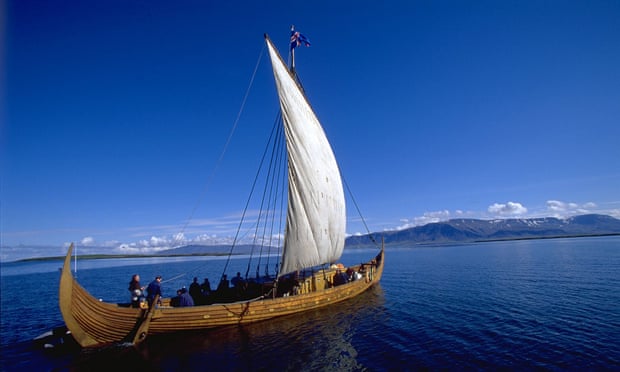Oliver Milman Saturday 5 December 2015
New analysis casts doubt on theory that change in climate influenced Vikings to move to Greenland in 985, and posits it would have been relatively cold
The replica Viking ship Icelander. Photograph: Thorkell Orkelsson/AP
The Vikings’ arrival and departure from Greenland was not heavily influenced by the so-called medieval warm period, according to new research that casts doubt that the climatic change was a global phenomenon.
Viking seafarers, led by Erik the Red, are understood to have expanded from Iceland to south-western Greenland around 985. The Norse population grew to about 3,000 to 5,000 settlers, harvesting walrus ivory and raising livestock. But the colonies disappeared by 1460, with the local Inuit population remaining as the only inhabitants before Europeans again arrived in the 1700s.
Previous theories have suggested that a warming climate allowed Norse people to push further north to the frigid expanses of Greenland, before leaving as temperatures dropped again. In what has become known as the medieval warm period, temperatures rose from around 950, with the generally balmier conditions lasting until 1250, before the arrival of what is known as the little ice age.
But new analysis of glaciers in Greenland shows that there was no significant change in their extent during the medieval warm period, suggesting that it remained relatively cold throughout the Viking colonisation of Greenland.
US geologists measured an isotope found in rocks once covered by glaciers to determine how long they have been exposed to sunlight. The results from western Greenland and Baffin Island show there was no major fluctuation during the medieval warm period, with other records from sites closer to Viking settlements showing the same.
While it takes some time for glaciers to retreat due to warming temperatures, scientists say there would have had to have been a huge increase in precipitation, of around 50%, to have held the Greenland glaciers steady. As there is no evidence of such an increase in rainfall, the research suggests that the medieval warm period was confined to certain areas, such as Europe, and did not stretch to all corners of the world.
“The Vikings thrived for a few centuries in a cool climate before they left, so to say the cold made them leave is a bit of a stretch,” said Nicolas Young, a glacial geologist at Columbia University and lead author of the study, published in Science Advances.
“This is a regional study so we don’t want to say there was no medieval warm period,” Young said. “In Europe it was certainly warmer. We just aren’t sure there was the warming we saw in Europe as the glaciers look fairly healthy throughout this time.”
Previous research has painted a complex picture of the climate of Greenland during Norse occupation. Study of an ice core extracted in 2011 shows temperatures dropped as Vikings arrived, with warming intervals during their stay. A separate study suggests it may have been warmer when the Norse arrived but then the climate started cooling in 1160, before the start of the little ice age.
Astrid Ogilvie, a climate historian currently at Iceland’s Akureyri University, said: “I do not like the simplistic argument that the Greenland people went there when it was warm, and then ‘it got cold and they died.’
“I think the medieval warm period has been built on many false premises, but it still clings to the popular imagination.”
There are several other potential reasons why the Norse departed Greenland. The value of ivory from walrus tusk may have dropped, removing the economic reason to colonise the area. There may also have been conflict with the local Inuit population.
“I don’t want to say climate didn’t play a role, but this suggests that socio-economic reasons were more important,” Young said. “It’s probably a combination of factors but we need to think about this a bit more.”
If the medieval warming period was localised, it sets it apart from the current rise in temperatures that has reached every corner of the world. Indeed, the polar areas have warmed more sharply than other parts of the planet.
A study published in August states that the current decline of the world’s glaciers is “historically unprecedented”. Researchers have identified rapid rises in melt water and alarming cases of glacial retreat in Greenland, west Antarctica, the Canadian and Alaskan coastal mountains, in Europe and in the Himalayan massif.
One satellite-based study, confirmed by on-the-ground measurements, of the Jakobshavn glacier in Greenland, confirms that the river of ice is now moving at the rate of 46 metres a day, 17 kilometres a year, which is twice the speed recorded in 2003, which in turn was twice as fast as measured in 1997.
Vikings were not spurred to Greenland by warm weather, research shows | World news | The Guardian

